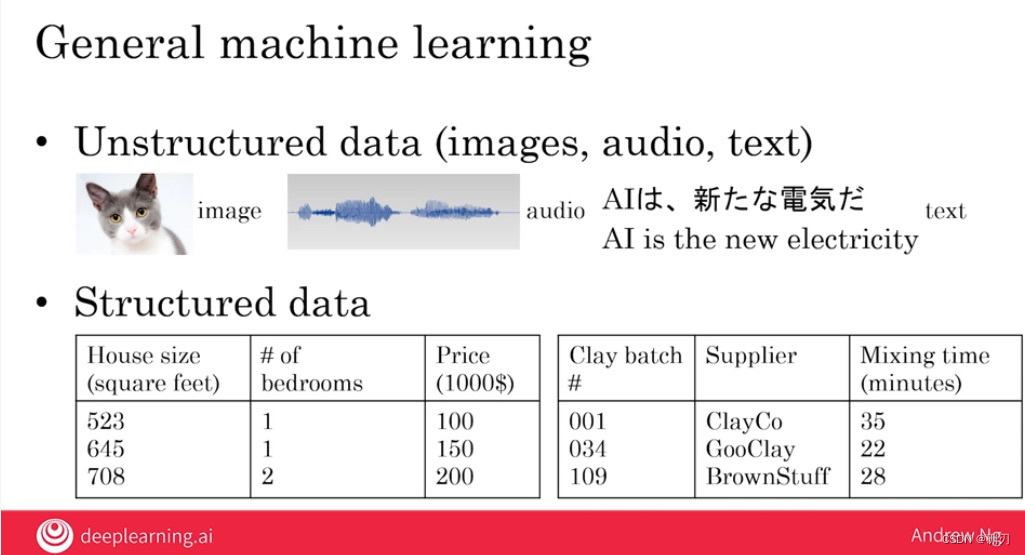Lesson 1 Introduction
This week you'll see you how multiple modules can come together to build a much more complex AI product such as a smart speaker or a self-driving car. You also learn what are the major roles in an AI team.
Lesson 2 Case study : Smart speaker
how do you build a piece of AI software to understand a command like this and executes on it?
Step one is the trigger word or the wake word detection. The speaker uses a machine-learning algorithm to input the audio clip and output.
step two, which is speech recognition.
Whereas the first step here used an A to B mapping to just tell it that it heard the trigger word, this uses a different A to B mapping to map the audio to a text transcript of what you just said, which in this case is the four words: tell me a joke. Now, the algorithm has to figure out what you actually want by saying these four words. And so the third step is intent recognition. That means to take whatever you said and to figure out what you actually wanted to do.

you can think of the four steps of the algorithm as these four steps, where the first step is trigger word detection, second step, speech recognition, then intent recognition, and then finally, execution of what are the command the user asked the smart speaker to execute.
the key steps of executing these commands are trigger word or the wake word detection, speech recognition to transcribe the text in the command, intent recognition to figure out which of these functions or which of these commands you want to execute, and then a specialized program to execute whichever command you uttered.
Lesson 3 Case study: Self-driving car

Let's look at the three key steps of car detection, pedestrian detection, and motion planning in more detail.

Let's look at a bit more detail of how an actual self-driving car might work. This is a picture you've seen so far. Input image, radar, or Lidar, sensor readings into car detection and pedestrian detection, and that is then fed to motion planning to help you select your path and speed. Now in a real self-driving car, you would usually use more than just cameras, radar, and Lidar.

Lesson 4 Example roles of an AI team

Many AI teams will have Software Engineers in them. So, for example, for the smart speaker we needed to write specialized software to execute on the joke or to set a timer or to answer questions about today's weather. So, those are traditional software engineering tasks.
The second common role is the Machine Learning Engineer. So, Machine Learning Engineer might write the software responsible for generating the A to B mapping or for building other machine-learning algorithms needed for your product. So, they might gather the data of pictures of cars and positions of cars, train a neural network or train a deep learning algorithm and work iteratively to make sure that the learning algorithm is giving accurate outputs.
Another role that you sometimes hear about is the Machine Learning Researcher. The typical row of the Machine Learning Researcher is to extend the state of the art in machine-learning. Machine learning and AI more broadly are still advancing rapidly. So, many companies for-profit and non-profit, more have Machine Learning Researchers responsible for extending the state-of-the-art. Some Machine Learning Researchers will publish papers, but many companies also have Machine Learning Researchers that do research, but are less focused on publishing.

With the rise of big data, there are also more and more Data Engineers whose main role is to help you organize your data, meaning, to make sure that your data is saved and is easily accessible, secure and cost-effective way.
Finally, you'll also hear some people refer to AI Product Managers whose job is to help decide what to build. In other words, they help to figure out what's feasible and valuable. Traditional Product Manager's job was already to decide what to build as well as sometimes some other roles, but the AI Product Manager now has to do this in the AI era and they're needing new skill sets to figure out what's feasible and valuable in light of what AI can and cannot do today.
Lesson 5 AI Transformation Playbook (Part 1)
Five steps of the AI transformation playbook
Step one is for your company to execute pilot projects to gain momentum.
when selecting your initial project, try to pick something that you think has a good chance of success. They can start to fly wheel turning even if it may not be the most valuable project that you could eventually do for the company. Because the goal of the first few projects is just to gain momentum is also now you see if you can pick something that can show traction within six to 12 months. So you can start to fly wheel turning quickly.
Step two, is to build an in-house AI team.

Wu thinks it is hopeful if to get the AI units started the company or the CEO provides funding to build at the AI unit rather than required AI unit to get funding from the business units.
Step three, is to provide broad AI training, not just the engineers but to many levels within a company including executives.

Step four, is to develop your AI strategy.
Step five, is to develop internal and external communications about your company and AI.
Lesson 6 AI Transformation Playbook (Part 2)
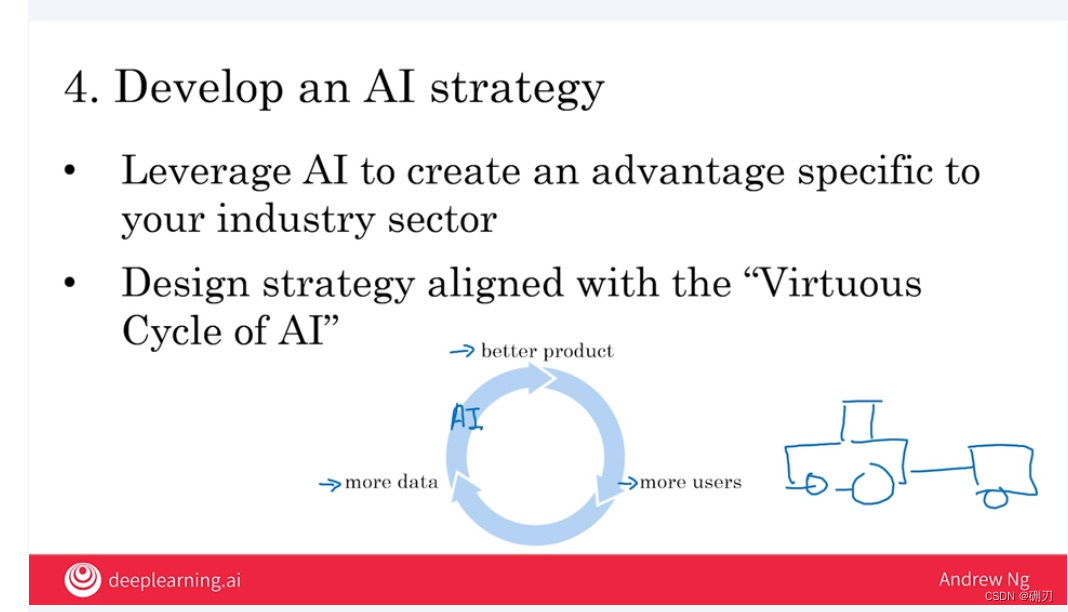
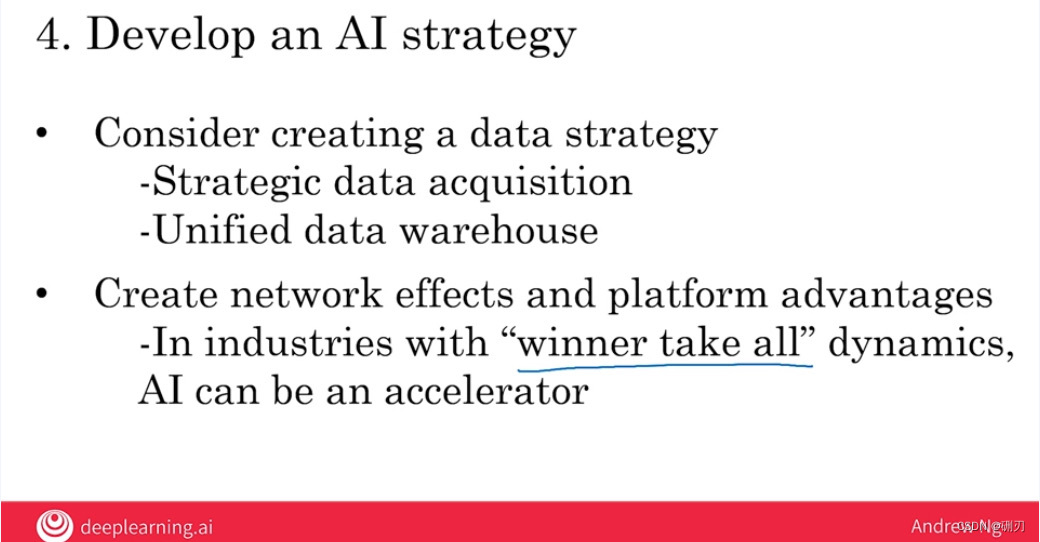
And so for AI to affect these highly regulated industries, I think it's important for companies to communicate with governments and to work collaboratively with them in public-private partnerships.

Lesson 7 AI pitfalls to avoid
Let's go over five dots and do if you're trying to build AI for your company. First one, don't expect AI to solve everything.
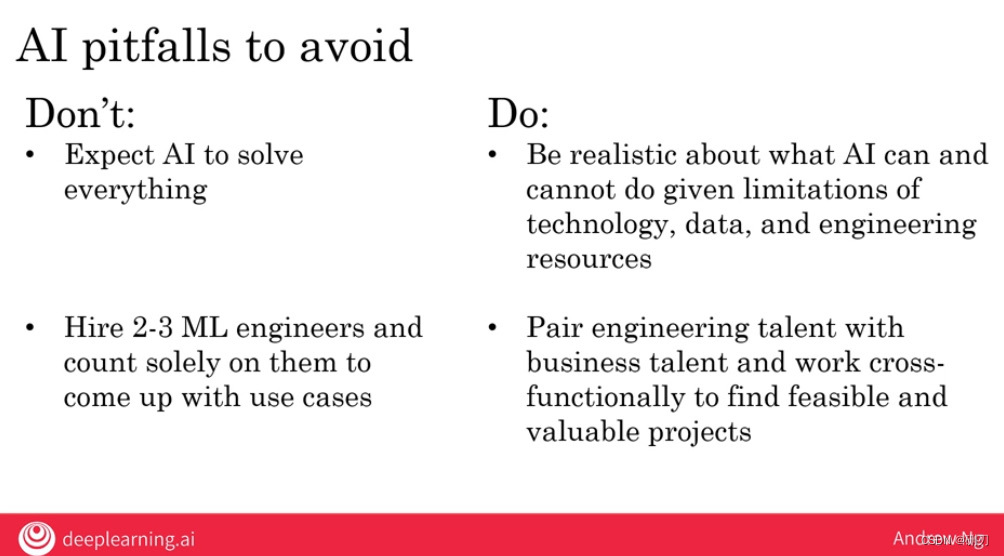
Second, don't just hire two or three machine learning engineers and count solely on them to come up with use cases for your company. Machine learning engineers are a scarce resource, but you should instead pair the engineering talent with business talent and work cross functionally to find feasible and valuable projects. It is often the combination of the machine learning talent with the business talent that can select the most valuable and feasible projects.
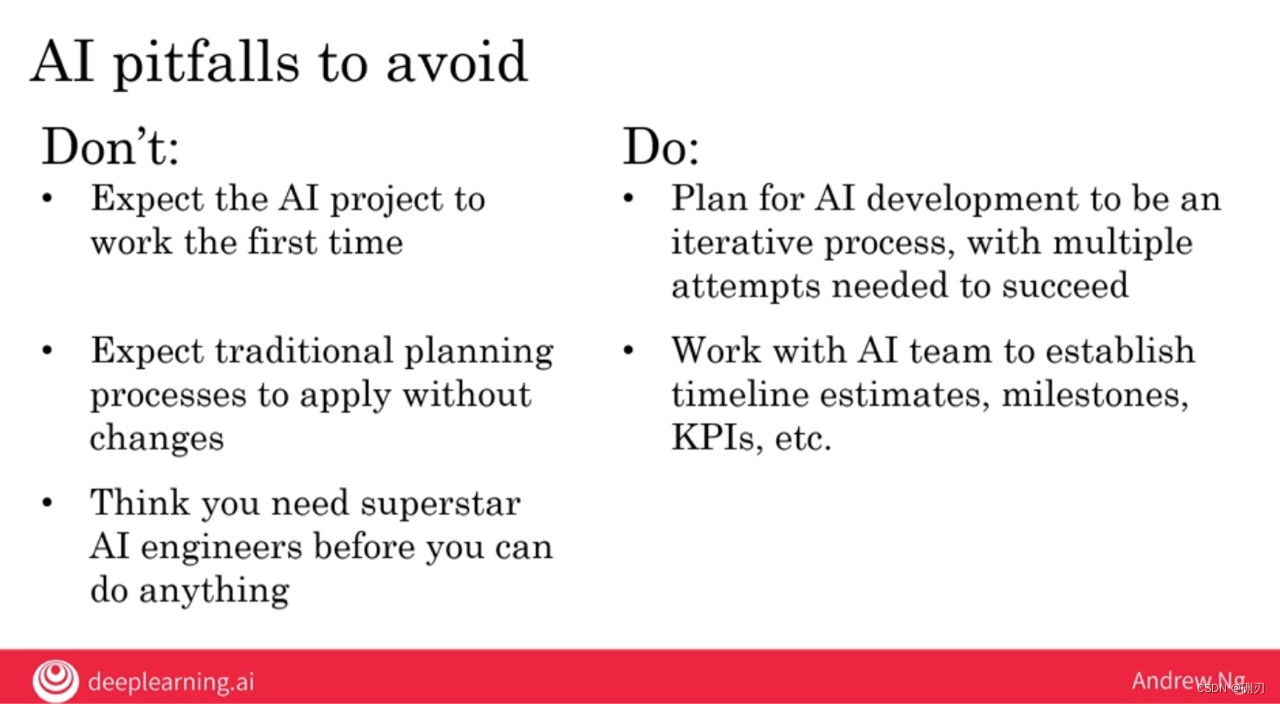
Lesson 8 Taking your first step in AI

Lesson 9 Survey of major AI application areas(optional)

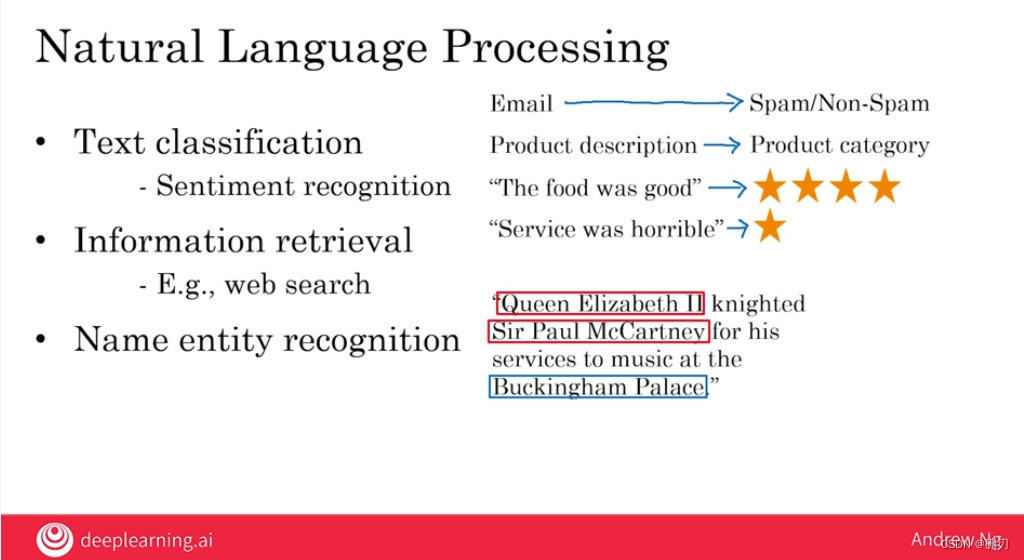
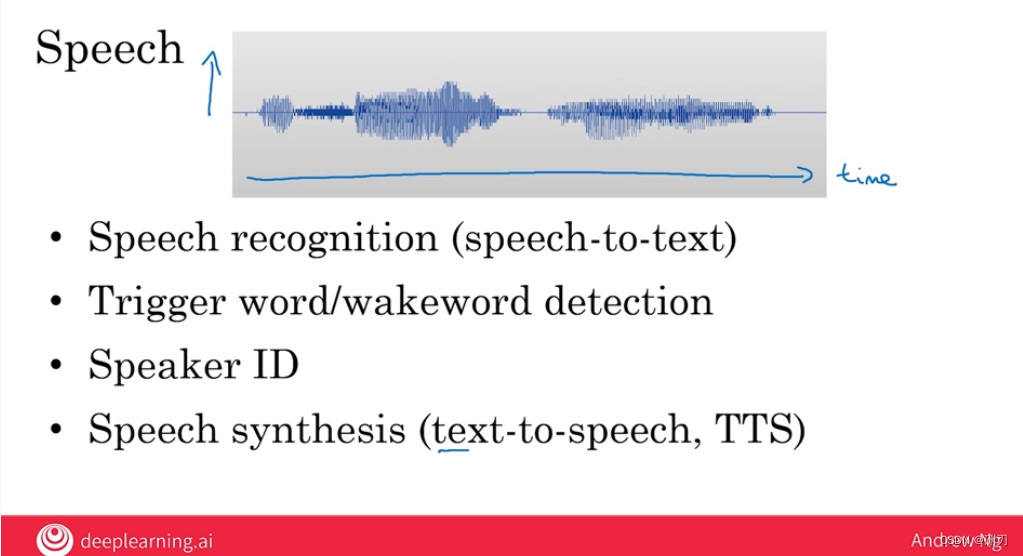
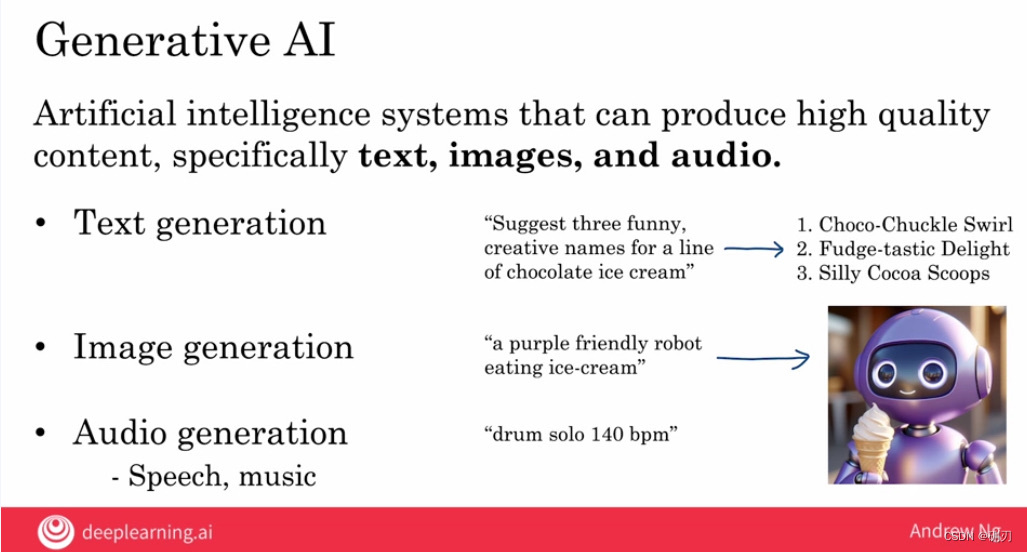
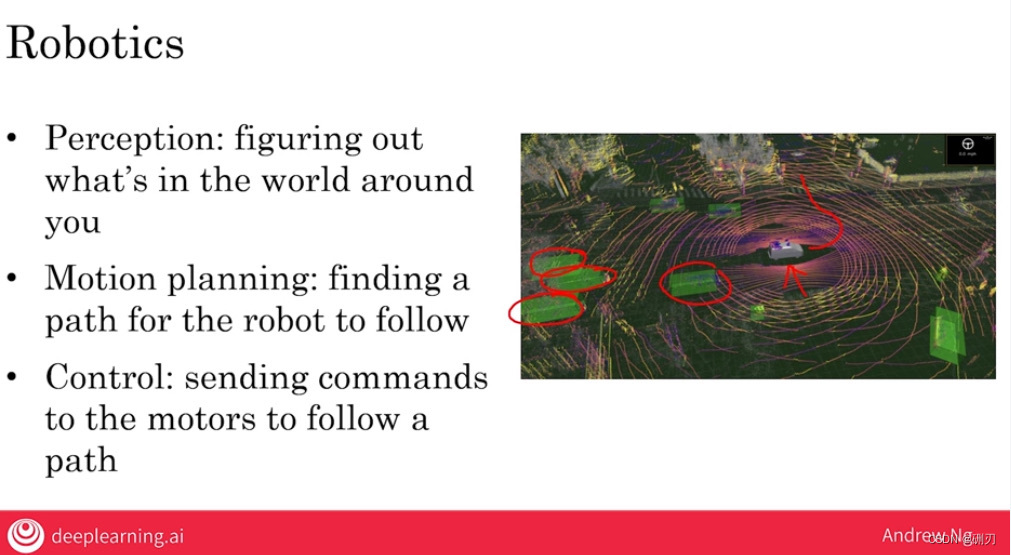
Lesson 10 Survey of major AI techniques(optional)
A clustering algorithm looks at data like this, and automatically groups the data into two clusters or more clusters, and is commonly used for market segmentation.

Whereas supervised learning algorithms run an A to B mapping, and you have to tell the algorithm what is the output B that you want, an unsupervised learning algorithm doesn't tell the AI system exactly what it wants. Instead it gives the AI system a bunch of data such as this customer data, and it tells the AI to find something interesting in the data, find something meaningful in the data. And in this case, a clustering algorithm doesn't know in advance that there's a college student demographic and a working professional demographic. Instead, it just tries to find what are the different market segments without being told in advance what they are. So unsupervised learning algorithms, given data without any specific design output labels, without the target label B, can automatically find something interesting about the data.
AI systems(supervised one) today require much more labeled data to learn than when a human child or than would most animals. Which is why AI researchers hold a lot of hope out for unsupervised learning as way, maybe in the future, for AI to learn much more effectively in a more human like way, and more biological-like way for much less labeled data.

Transfer learning is the technology that lets you from a task A, such as car detection, and use the knowledge to help you on a different task B, such as golf cart detection. Where transfer learning really shines is if having learn from a very large dataset of car detection, task A, you can now do pretty well on golf cart detection, even though you have a much smaller golf cart dataset.

reinforcement learning algorithm uses a reward signal, to tell the AI when it's doing well or poorly. This means that whenever it's doing well, you give it a large positive number to give it a large positive reward. And whenever it's doing really bad job, you send it a negative number to give it a negative reward. And it's the AI's job to then automatically learn to behave so as to maximize the rewards.

One of the weaknesses of reinforcement learning algorithms is that they can require a huge amount of data. So, if you are playing a video game, a reinforcement learning algorithm can play, essentially, an infinite number of video games. Because it's just a computer playing a computer game, and get a huge amount of data to learn how to behave better. Or for playing games like checkers, or other games. It can play a lot of games against itself, and for free, get a huge amount of data to feed in its reinforcement learning algorithm.

GANs, or generative adversarial networks, are another exciting new AI technique.
GANs are very good at synthesizing new images from scratch. Let me show you a video generated by a team from NVIDIA, that used GANs to synthesize pictures of celebrities. And these are all pictures of people that had never existed before. But by learning what's celebrities look like from a databases celebrity images, it's able to synthesize all these brand-new pictures. There's exciting work by different things right now on applying GANs to the entertainment industry. Everything ranging from computer graphics to computer games, to media, and to just making up new contents like this from scratch.

If you do a search on Ada Lovelace, you'll also similarly find a panel of additional information on the right. This information is drawn from a Knowledge Graph, which basically means a database that lists people and key information about these people.
For example, a Knowledge Graph with hotel information may have a big database of hotels as well as key information about these hotels. So that if you look them up on the map you can find the right information relatively quickly.
AI For Everyone - Building AI In Your Company - Week 3 | Coursera
